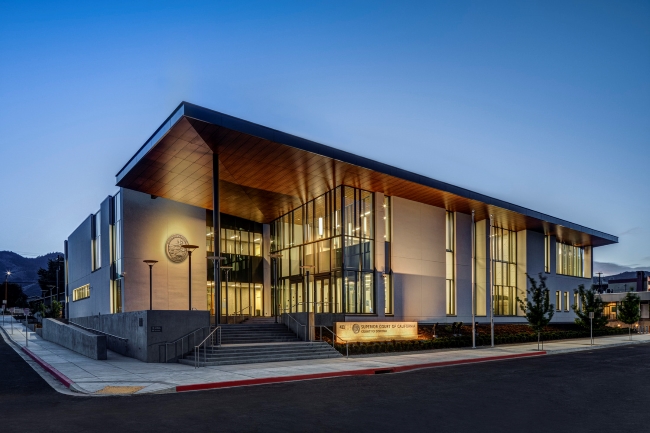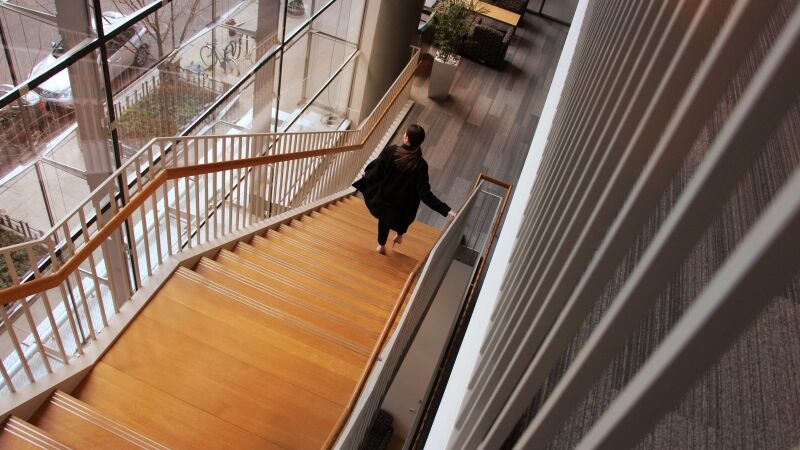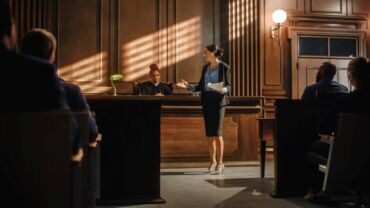Courthouses have had to serve an historical function while accommodating newer systems that are more human-centered and focused on access
Courthouses in the United States are often historic structures located centrally, and constructed of stone with Neoclassical features such as columns or domes. These iconic buildings —numbering more than 35,000 listed in the National Register of Historic Places alone — have long been symbols of civic pride and the importance of the nation’s justice system.
Yet today, as historic courthouses become functionally obsolete for continued use, architects are exploring designs that emphasize inclusivity and access to justice.
Tech and access key in court design
Common themes across three recently opened justice centers in Michigan and California, and a forthcoming one in Colorado include flexibility and inclusivity in design, building for the technological and space needs of the future, and incorporating design elements that promote safety and ease anxiety for all courtroom visitors and employees.
Charles A. Pratt Justice Center in Kalamazoo, Michigan
The Kalamazoo County Board of Commissioners aimed for a bright, welcoming experience in the Charles A. Pratt Justice Center, which opened in late 2023. Designed by TowerPinkster and HOK, the 165,000-square-foot facility consolidated operations from three separate facilities, including an historic courthouse. The new center enhances user experience with a well-lit atrium that eases entry and diminishes the intimidation of security checkpoints. Airport-style message boards assist visitors in navigating the space. Public lobbies and the juror assembly room offer various seating options, including quiet space and a lactation room for comfort. There are also water bottle filling stations, charging ports, and modern high-speed elevators that replaced early-20th century ones.
Dignity and safety were top priorities in the building design, with technological connectivity enabling more virtual hearings, the use of which has increased approximately 25% in recent years. In-person appearances for in-custody defendants now feature enhanced safety and privacy during transport by using secure entry and private elevators shielded from public view.
In addition, clear sightlines and passive security elements like landscape berms and stone walls enhance safety without compromising the welcoming atmosphere. And functionally, the center expands access to justice through four public terminals providing free access to state and county case management systems. Self-help legal resources that direct users to common statutes more readily provides existing resources to users. The facility also houses a booth for indigent defense resources and a standalone housing resource office for individuals facing eviction or foreclosure.
Imperial County Criminal Courthouse in El Centro, California
Safdie Rabines Architects aimed to create comfort in the harsh desert surroundings of El Centro, California with the design of the El Centro Courthouse, which opened in January 2024. The 48,000-square-foot facility consolidated operations from two separate buildings, including a historic 1923 courthouse. Similar to the Charles A. Pratt Justice Center, it features self-help resources, integrated audio-video technology, and separate transport options for in-custody defendants.
The courthouse design is starkly non-institutional, offering a surprisingly warm and bright space. Architectural stone elements, warm wood accents, and ample natural light enhance the comfortability of the space. Two interior courtyards in the project footprint allow for the public and staff to spend time outside without leaving the secure premises and ensure that more offices have natural lighting. Security elements, such as large boulders, blend with natural surroundings. North-facing windows maximize natural light, while reducing solar heat gain.
The space is also home to the county’s new Collaborative Justice Court (CJC) program, which aims to find alternatives to incarceration in the hopes of reducing recidivism. Participants can utilize the Veteran’s Court, Drug Court, or Mental Health Court programs to address underlying issues, such as combat stress, substance use disorders, or mental health issues.
Siskiyou County Courthouse in Yreka, California
The Siskiyou County project replaced one of the oldest operating courthouses in California. And EHDD Architects sought to not only meet similar security standards as the Kalamazoo and El Centro projects, but also to create a facility which represented support of community members. The 67,000-square-foot, two-story structure fits the surrounding architectural context of the low-density historic downtown area and is intended to become a civic landmark for Siskiyou County.

The building now fully meets Americans with Disabilities Act (ADA) accessibility standards, whereas the prior 1954 facility required accessible entry from the rear of the building. Access to justice is expanded through an onsite family law facilitator who offers appointments and walk-in services on a daily basis for individuals in need of self-help legal assistance. Both attorneys and members of the public can take advantage of more than three dozen wireless access points in the family law facilitator offices.
A secure, exterior courtyard provides break space for staff members within the secure premises. Natural light and views of the surrounding Shasta Valley and Siskiyou Mountains, as well as public art installations soften the courtroom experience. Wood is a primary architectural material in the canopy and atrium ceilings, as a nod to Yreka’s historic timber industry. Function was equally important to architectural form for this project through the use of building materials which are responsive to the fluctuating Northern California desert temperatures and with long-term maintenance in-mind.
Westminster Municipal Courthouse Project in Westminster, Colorado
The City of Westminster is redesigning its municipal courthouse — aiming to replace the 1960s era building which was originally a municipal and police facility — in order to prioritize modern safety, security and ADA standards.
Led by Anderson Hallas Architects and Reilly Johnson Architecture, the project focuses on flexibility and technology-integration to enhance access to justice and keeping pace with the evolution of modern courtroom evidence. Features include enhanced audio systems, For the Record speech-to-text court reporting, and individual displays at every seating position (jurors, counsel tables, gallery, witness stand, and bench) to better convey social media, video, and photo evidence. As the municipality’s first purpose-built courthouse, flexibility in design for future needs is key. Design preferences have included a hearing room that can be expanded into an additional courtroom as needed, spaces which are multipurpose, such as flexible conference and meeting rooms which are acoustically separated.
Civic spaces of the future
Contemporary courthouses across the United States are being designed to address technology and space needs for the future, while also maintaining their presence as symbols of civic pride. These four facilities exemplify this trend with designs that strike a balance between a non-institutional look and one that still meets the need for increased security.
Community-informed processes and interior design choices encourages access to justice and reduces the stress and anxiety of court interactions for users while emphasizing that courts are human-centered places in which solutions can be sought.







